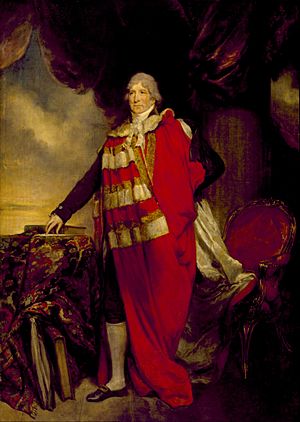James Duff, 2nd Earl Fife facts for kids
Quick facts for kids
The Earl Fife
|
|
|---|---|

The Earl Fife by Arthur William Devis
|
|
| Member of Parliament for Elginshire |
|
| In office 1784–1790 |
|
| Preceded by | Lord William Gordon |
| Succeeded by | Lewis Alexander Grant |
| Member of Parliament for Banffshire |
|
| In office 1754–1784 |
|
| Preceded by | James Abercrombie |
| Succeeded by | Sir James Duff |
| Personal details | |
| Born | 29 September 1729 |
| Died | 1809 |
| Nationality | British |
James Duff, 2nd Earl Fife (born 29 September 1729 – died 1809) was an important Scottish noble and a Member of Parliament. This means he was elected to represent an area in the British government.
Contents
Early Life and Family
James Duff was the second son of William Duff, 1st Earl Fife. His mother was Jean Grant. His father, William Duff, was also a Member of Parliament for Banffshire. In 1735, his father was given the title of Lord Braco. Later, in 1759, he became the Earl of Fife and Viscount Macduff. These were special titles given to nobles in Ireland. The family proved they were related to Macduff, an ancient Earl of Fife.
A Life in Politics
In 1754, James Duff became a Member of Parliament for Banffshire. He was re-elected several times. In 1784, he was elected to represent Elginshire until 1790.
James Duff was very influential in parts of Scotland like Aberdeenshire and Banffshire. This was because he owned a lot of land. He gave the town of Doune in Banffshire its new name, Macduff, in 1783. He also helped the town grow by building a harbour, which cost a lot of money. This helped the town's economy.
Because he spent a lot of time in London for his political work, others helped manage his large estates. One important person was William Rose. James Duff rewarded Rose for his help. He gave Rose the right to vote in three different areas. He also made him the first leader of Macduff and later the Sheriff Clerk of Banffshire.
In 1790, James Duff was given another special title: Baron Fife. This made him a British noble. He also held the position of lord-lieutenant for Banffshire, which meant he was the King's representative in that area.
Improving the Land
When his father passed away in 1763, James Duff inherited his titles and estates. He worked hard to make his properties better. He bought more land in northern Scotland, making his estates even bigger.
He was given a gold medal twice by the Society for the Encouragement of Arts, Manufactures, and Commerce. This was for planting trees on a huge area of land, about fourteen thousand acres! He encouraged farmers on his land to use the best farming methods. He even set up special "model farms" near his homes. On these farms, he showed how to grow crops and raise animals in the best ways.
In 1782 and 1783, when crops failed, he helped his tenants. He lowered their rent by 20 percent. He also sold grain to poor people for much less than the market price. He even bought grain from England and sold it at a loss of £3,000 to help those in need.
In 1787, he became a Fellow of the Royal Society. This is a group of important scientists and thinkers.
Family Life
James Duff married Lady Dorothea Sinclair in 1759. She was the only child of the 9th Earl of Caithness. They did not have any children together. Because of this, his British noble title ended when he died. His Irish earldom was passed on to his younger brother, Alexander.
Before his marriage, James Duff had three children with Margaret Adam. His eldest son, James, grew up to become a general in the army and a Member of Parliament.
Death
James Duff passed away at his home in London on 24 January 1809. He was buried in the family mausoleum at Duff House in Banffshire, Scotland.
Images for kids


